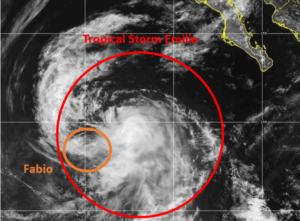The potential threat posed by a tropical wave east of the Lesser Antilles prompted the issuance of Tropical Storm Watches for the Leeward Islands on Sunday afternoon. The U.S. National Hurricane Center designated the tropical wave as Potential Tropical Cyclone Five for the purpose of issuing the Tropical Storm Watches. At 5:00 p.m. EDT on Sunday the center of Potential Tropical Cyclone Five was located at latitude 13.6°N and longitude 48.0°W which put the center about 950 miles (1530 km) east-southeast of Antigua. The tropical wave was moving toward the west-northwest at 21 m.p.h. (33 km/h). The maximum sustained wind speed was 30 m.p.h. (50 km/h) and there were wind gusts to 40 m.p.h. (65 km/h). The minimum surface pressure was 1010 mb.
Tropical Storm Watches were in effect for Guadeloupe, St. Martin, St, Kitts, Nevis, Montserrat, Antigua, Barbuda, and Anguilla, Saba and St. Eustatius, and Sin Maarten.
The U.S. National Hurricane Center designated a tropical wave east of the Lesser Antilles as Potential Tropical Cyclone Five on Sunday afternoon. There was not a well defined low level center of circulation in the tropical wave. There was a large counterclockwise rotation associated with the tropical wave, but the rotation did not have an identifiable center. Thunderstorms were forming in clusters scattered within the tropical wave.
Potential Tropical Cyclone Five will move through an environment somewhat favorable for the formation of a tropical cyclone during the next 36 hours. The tropical wave will move over water where the Sea Surface Temperatures are near 29°C. It will move under the southern part of an upper level ridge over the subtropical Atlantic Ocean. The ridge will produce strong easterly winds that will blow toward the top of the tropical wave. Those winds will cause moderate vertical wind shear. The wind shear will slow the organization of the tropical wave into a tropical cyclone. Potential Tropical Cyclone Five is likely to organize gradually into a tropical depression or a tropical storm during the next 36 hours.
Potential Tropical Cyclone Five will move around the southern side of a subtropical high pressure system over the Atlantic Ocean. The high pressure system will steer the tropical wave quickly toward the west-northwest during the next 36 hours. On its anticipated track, Potential Tropical Cyclone Five could approach the Leeward Islands on Monday night.
Potential Tropical Cyclone Five could be a tropical storm when it reaches the Leeward Islands. It will bring gusty winds and locally heavy rain to the Leeward Islands. Heavy rain is likely to cause flash floods in some locations.

